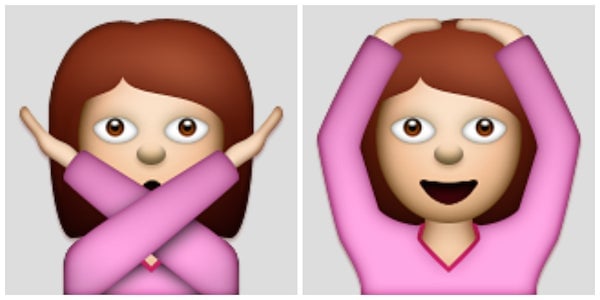The origins of two cryptic emoji
Four years ago, emoji were mostly confined to Japanese cell phones. Today, they’re on practically every electronic device you can buy. But even though emoji are almost completely textless, their translation to other cultures hasn’t been perfect.

Four years ago, emoji were mostly confined to Japanese cell phones. Today, they’re on practically every electronic device you can buy. But even though emoji are almost completely textless, their translation to other cultures hasn’t been perfect.
Consider these two emoji: The first one is a woman crossing her arms across her body in an X, like a stern air-traffic marshall. The second one shows the same woman, now smiling and making a circle with her arms. Is she stretching? Ballet dancing?
The Unicode Consortium, the organization that standardizes characters across most platforms, refers to these two emoji as U+1F645 (“FACE WITH NO GOOD GESTURE”) and U+1F646 (“FACE WITH OK GESTURE”). (On Android devices, they’re yellow, gender-neutral blobs.) That gives a sense of how we’re supposed to interpret them, but it doesn’t clear up the mystery of how the gestures came to be assigned those particular meanings.
A recent essay in Medium by Lauren Archer offers a clue. The ”X” icon is now a standard symbol in computer graphics for closing a window, and Archer wanted to know why. She found an early use of “X to close” in an Atari operating system from 1985 and speculated that Atari, an American company with a Japanese name, had also borrowed the meaning of the “X” from Japanese culture. She explains:
The use of [x] for close and [o] for open could come from the Japanese symbols batsu and maru.
Batsu (x) is the symbol for incorrect, and can represent false, bad, wrong or attack, while maru (o) means correct, true, good, whole, or something precious. Batsu and maru are also common hand gestures. Cross your arms over your chest for batsu, circle your arms over your head for maru.
Look at those two emoji again. The gestures track perfectly with batsu and maru.
Emoji originated 15 years ago in Japan, and the man who developed them acknowledges a debt to Japanese manga comics and kanji characters. It stands to reason that batsu and maru, which are widely used in Japan as shorthand symbols, would have been natural references as well.